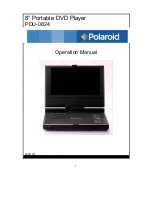
8
OPM-132/D
INITIAL START UP
The throttle control on these generators is preset and
locked to operate at 3600 RPM (nominal) with no load
speed set at 3690 RPM. Only a trained service technician
should be allowed to adjust this speed setting.
BASIC OPERATION
MANUAL STARTING
Refer to the engine manual for additional starting,
operating, and stopping instructions
1. Check oil level, refill as needed.
2. Turn on the fuel supply. Ref “A”.
NOTE: There is a second fuel valve under the fuel tank that
is used when removing the tank. This valve is normally left
on.
3. Engage the choke (“B”) by pulling it out. A warm
engine will require less choking than a cold engine.
4. Rotate the key switch (‘C’) to the run position.
5. Pull the starter grip lightly until resistance is felt, then
pull briskly.
6. When the engine starts, open the choke gradually.
7. The engine should promptly come up to operating
speed.
CAUTION:
Do not allow the starter grip to snap back against the
engine. Return it gently to prevent damage to the starter.
ELECTRIC STARTING
If the engine is cold and stiff or if the battery is not fully
charged, starting can be made easier by slowly hand
cranking the engine through the compression stroke before
pushing the starter switch. This permits the starter to gain
momentum before the heavy load of the compression
stroke occurs. This minimizes the drain on the battery and
improves the possibility of starting under such adverse
conditions. Always keep the battery charged, especially
during cold weather operation.
1. Check oil level, refill as needed.
2. Turn on the fuel supply. Ref “A”.
3. Engage the choke (“B”) by pulling it out. A warm
engine will require less choking than a cold engine.
4. Rotate the key switch (‘C’) briefly to the START
position. Repeat if necessary.
A
B
C
1. CHECK OIL LEVEL
2.CHECK & CLEAN AIR CLEANER
3. CHANGE OIL
4. REPLACE OIL FILTER
5. CLEAN COOLING FINS
See Operating and Maintenance Instruction
s
8 hours
25 hours
100 hours
100 hours
100 hours
CHOKE
RUN
COMMERCIAL POWER
BRIGGS & STRATTON
TM
R
NOTE: The starter life is improved by using shorter cycles
with time to cool off between cranking cycles. Do NOT
operate the starter more than 15 seconds during each
minute.
5. Gradually push the choke as the engine warms up.
6. The engine should promptly come up to operating
speed.
CAUTION: EQUIPMENT DAMAGE
Never permit the choke to remain on after the engine has
run for a short time. It is not necessary to choke the engine
when it is warm. Avoid over-choking.
STARTING HINTS
1. COLD WEATHER
A. Use the proper oil for the temperature expected.
B. Use fresh winter grade fuel. Winter grade gasoline is
blended to improve starting. Do not use summer grade
gasoline.
2. HOT WEATHER
A. Use the proper oil for the temperature expected.
B. Use only summer blended gasoline. Using gasoline left
over from winter may cause the unit to vapor lock.
STOPPING AND STORING
1. Move the key to the “OFF” position.
2. Turn off the fuel supply valve.
3. Before extended storage (over 30 days) certain
precautions must be taken to ensure the fuel doesn’t
deteriorate and clog the fuel system.
NOTE:
The use of a fuel additive, such as Sta-Bil or
equivalent will minimize the formation of gum deposits
during storage. The additive may be added to gasoline in
the engines fuel tank or to gasoline in a storage container.
A. Add the fuel stabilizer to the fuel in the tank and run
for 2 minutes to circulate the stabilizer throughout the
fuel
system.
B. If you choose to remove the remaining fuel from the
fuel tank, it must be drained into an approved
container.
C. Start the engine and allow it to run until all the fuel in
the carburetor and the fuel lines has been used up and
the engine stops.
NOTE:
Running the engine to use up the fuel in the lines
and carburetor will still leave a small amount of fuel in
carburetor. It is best extended storage practice to treat the
fuel before draining.
D. While the engine is warm, drain the oil and refill with
fresh
oil.
E. Clean dirt and chaff from cylinder, cylinder head fins,
blower
housing, screen, and muffler areas.
F. Store in a clean and dry area.


































